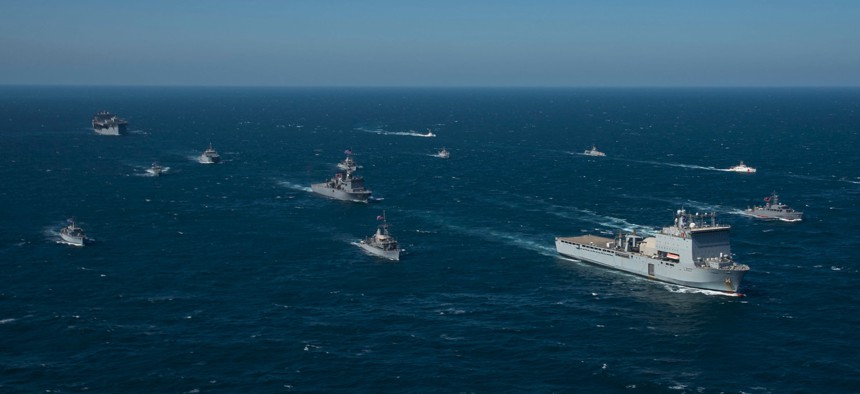
Ships from partner nations of Combined Task Force North participate in a photo exercise during International Maritime Exercise/Cutlass Express (IMX/CE) 2022 in the Persian Gulf on Feb. 9, 2022. U.S. Navy / Mass Communication Specialist 2nd Class Helen Brown
Navies don't agree on naval-warfare law. Here's how to keep legal fissures from sinking your coalition
A new manual can help the U.S. and its partners stay on the same page.
Just as no U.S. or combined force would go to war without knowing the law of armed conflict, none should face the uncertain and perilous situation in the western Pacific without a firm grasp of the legal principles that guide naval warfare. Yet this task is complicated by the diverse views held by the world’s various navies. A new manual produced by an international team of experts lays out the rules—and fissures—in this important but too-little-understood area of the law. The U.S. military should hasten to digest and incorporate it, from unit training to multinational exercises.
Powerful and influential maritime powers have genuine differences in how they interpret and apply the law of naval warfare. States reasonably disagree, for example, on the permissible scope of targeting the enemy’s warfighting or war sustaining effort, such as oil tankers. Similarly, allies may disagree on applying some elements of the law of naval warfare, such as blockade, in “non-international armed conflicts,” such as civil war. And while many NATO states are party to the Hague Conventions and Additional Protocol I of the Geneva Conventions, the United States has not joined all these agreements and does not accept all their provisions as binding customary law.
These questions will loom large in any naval conflict in East Asia, and even in routine operations far short of it. The recent transit of the Taiwan Strait by the USS Chung-Hoon and Canada's HMCS Montreal underscore that allies are operating in areas of potential danger. While these two allies share strategic interests and values, they have divergent views on some aspects of the law of the sea and the law of naval warfare. To effectively integrate operations, they must understand each other’s approach.
To be sure, many countries have official publications laying out their naval operational law doctrine. The U.S. Navy has The Commander’s Handbook on the Law of Naval Operations (2022), as well as the 1955 Naval Warfare Publication 10-2, the service’ most recent authoritative restatement of the law of naval warfare. But these publications, useful as they are, contain only the U.S. perspective. During coalition operations, warfighters will have to understand and appreciate how allies and partner nations apply the law during conflict at sea.
Until recently, there was no single source to guide combined operations, no authoritative guide to the law of naval warfare at sea in such situations that could inform commanders and their staffs. In 1994, a group of scholars released the San Remo Manual on International Law Applicable to Armed Conflicts at Sea. But the San Remo Manual includes numerous progressive statements that do not reflect state practice or actual international law, such as introducing peacetime coastal state authority over marine resource conservation and marine environmental protection into the law of armed conflict or affording special protection to vessels engaged in marine environmental protection. And, as a product of the 1990s, it also does not foresee unmanned and autonomous warships and the vital roles these vessels already serve in today’s naval force structure or the integrated role they will play in Force Design 2045.
To remedy this gap, an international team of experts from Australia, Germany, India, Japan, the United Kingdom, and the United States have produced The Newport Manual. The Manual is the first effort since 1955 to restate the law of naval warfare as a purely lex lata exercise—that is, law as it is, not as it should or might be (lex ferenda). The Manual aimed to provide an authoritative guide of the rules and principles of naval warfare as understood and applied by diverse maritime powers, and a practical handbook for commanders and seafarers, lawyers and officials, and educators and students.
We also sought to describe legal approaches by states in novel areas such as unmanned systems. The Newport Manual acknowledges state practice in this regard, recognizing that flag states may commission unmanned warships that are entitled to sovereign immunity, enjoy navigational rights, and have belligerent rights in the law of naval warfare, including strike operations.
Unlike the reservoir of expertise in the law of armed conflict built up during recent wars that consisted largely of ground operations, the United States and its allies and partners have limited recent experience in the law of naval warfare. Now, with tensions rising in the western Pacific, the U.S. armed forces and its international allies and partners are focused on maximizing exercises and training to improve interoperability. These must include a focus on the law of naval warfare, and should draw upon the new Newport Manual. Ensuring allies and partners understand how each approach the nuances of the law of naval warfare facilitates interoperability, increasing deterrence in peacetime, and synchronizing coalition operations during armed conflict.
James Kraska is Charles H. Stockton Professor of International Maritime Law at the U.S. Naval War College. He is a co-author of The Newport Manual.




